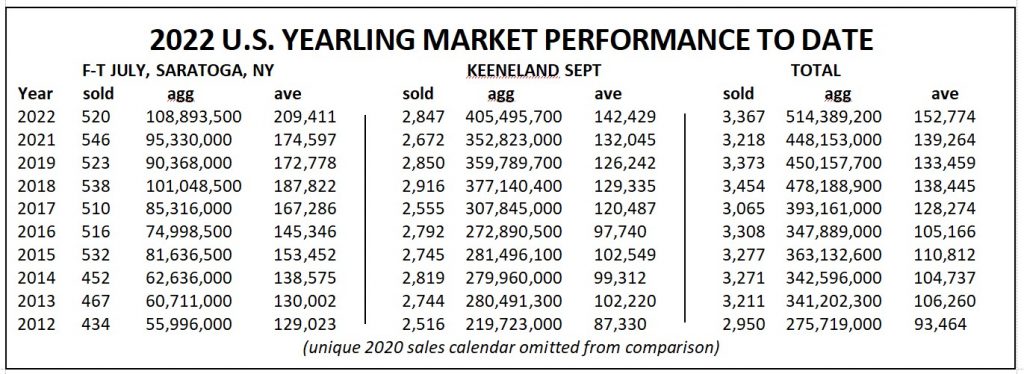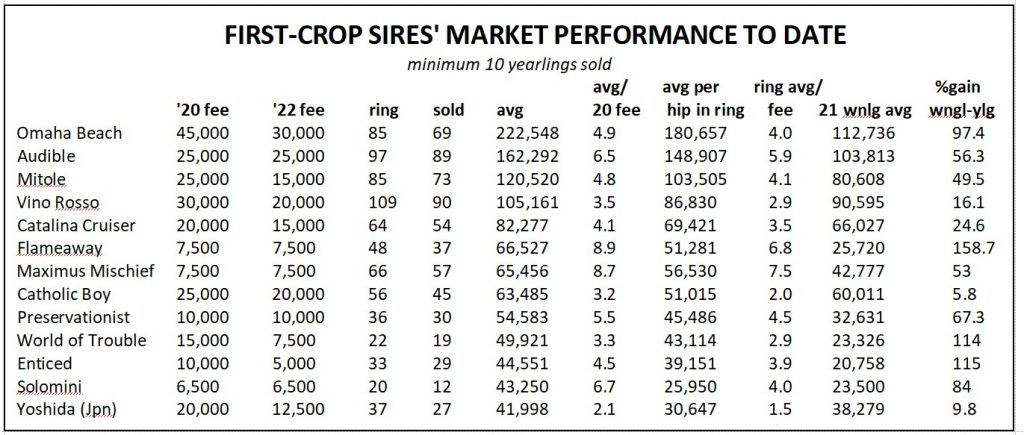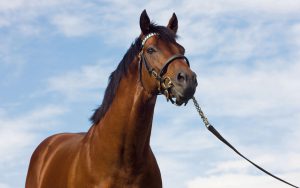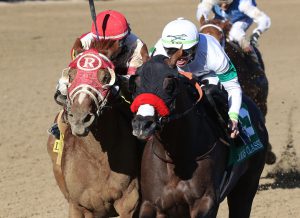Traducción de Herman Guanipa
La frase pertenece a Bob Hope, aparentemente cuando fue interrumpido por una persona que lo retó durante una alocución sobre moral militar para explicar por qué no estaba en uniforme. “¿No sabes que hay una guerra?” respondió. “¡Un chico podría lastimarse!”
Habría sido perfectamente legítimo que uno de los subastadores de Keeneland respondiera de igual manera a la gran cantidad de pujas que llevó a la subasta de septiembre a niveles sin precedentes. De alguna forma, el tipo de factores que tradicionalmente llevan a los mercados a una caída libre angustiosa, no han logrado detener una carrera alcista agobiante en los caballos de carreras. ¿Estas personas no tienen televisores o periódicos?
La resistencia del mercado en el transcurso del COVID fue lo suficientemente sorprendente. Muchos buscamos explicar eso por el deseo reprimido de aprovechar al máximo la vida, después de estar tan aburridamente confinados. También existía la sensación de que el nivel más próspero de la sociedad, del que depende tan ingenuamente nuestra industria, había sido aislado del tipo de estrés financiero que se experimentaba en la base de la pirámide social.
Después de todo, los ricos se habían beneficiado durante la década anterior de la liquidez aplicada (a través de uso dinero en efectivo como instrumento para disminuir las tasas de interés que lleva al aumento del gasto en la economía) para apagar los incendios de la crisis bancaria; y esos grifos nunca se habían cerrado realmente, incluso después de que la inestabilidad pasó. Pero ahora tenemos una inflación galopante, tenemos el horrible regreso de la invasión territorial en Europa, tenemos pronósticos de recesión en muchos países y, aún así, el valor de los Purasangres de Carreras sigue aumentando.
La siguiente tabla muestra que en el 2022 el costo promedio de un yearling norteamericano ha superado los $ 150,000 en un mercado que ha rebasado otra barrera histórica de $ 500 millones para esta época del año. Esto se calcula al agregar las tres subastas de verano de Fasig- Tipton: la venta de julio en Lexington más las selectas de Nueva York en Saratoga, combinado con la facturación en Keeneland durante las últimas dos semanas, donde las transacciones oscilaron entre $ 2,000 y $ 2,5 millones. Juntos, como tales, reúne una imagen completa del mercado en todos los niveles.

La facturación en la venta de septiembre aumentó un 14,9 % respecto al año pasado para superar los $ 400 millones por primera vez (perdió por unos centavos con la del 2006); mientras que el programa de verano de Fasig – Tipton aumentó paso a paso en un 14,2 % para lograr un acumulado récord de casi $ 109 millones. En conjunto, se han gastado $ 66,236,200 adicionales en yearlings en Norteamérica en lo que va del año, un aumento del 14.8 % que suma $ 514,389,200. ¡Eso representa una ganancia del 86,6 % con respecto al año 2012!
Estos números se tradujeron en promedios récord de $ 209,411 para Fasig -Tipton, un asombroso 20% más que en el 2021; y $ 142,429 para Keeneland, un aumento de poco menos del 8%. Combinado, el promedio anual de un yearling te está costando $ 152,774 en 2022, $ 13,510 más o un 9.7 % adicional que en esta época el año pasado.
Mucho de esto tiene un impulso muy edificante. Varias regiones, entre ellas el propio Kentucky, han estado desarrollando una estructura de premios o dinero a repartir que amenaza con presentar algo lógico y consistente, así sea un rumor o un hecho, a la inversión en el Purasangre de Carreras. Tampoco debemos olvidar lo que le debemos a aquellos que heroicamente han restablecido el deporte hípico en California, transformando el balance geográfico desde una situación crítica al progreso. Y, por supuesto, el circuito allí ha producido un caballo de carreras que ha hecho que incluso una etiqueta de siete cifras parezca barata.
Pero el crecimiento perenne, en un mercado como este, es imposible. El capitalismo siempre ha dependido de ciclos, requiriendo valles para generar las condiciones para el próximo repunte. Es concebible que la globalización haya sesgado tanto el sistema que la élite puede permanecer alegremente inmune a las dificultades de la calle. Pero si la recesión termina penetrando todo el órgano económico, como siempre lo ha hecho en el pasado, entonces debemos darle la palabra a Cassandra, porque el mercado de caballos es propenso a absorber lentamente las tendencias de la economía en general, ya sea en recesión o recuperación.
El Dow Jones, después de haber caído un 33,8 % en 2008, recuperó un 18,8 % rápidamente al año siguiente y mantuvo sólidas ganancias anuales hasta 2015. El mercado general de caballos de carreras de Norteamérica, por el contrario, perdió un 21,2 % en 2008; 32,2 % en 2009; y otro 6,5 %, incluso con esas pérdidas indexadas, en 2010. No fue sino hasta 2011 (18,2 % más) y especialmente 2013 (27,9 % más, junto con el mayor repunte del Dow Jones) que su propia recesión se estabilizó.
Por el momento, sin embargo, debemos reconocer un gran entusiasmo en el mercado actual. Los vendedores siempre se quejan de la polarización, de un mercado medio o centro blando y de una actitud del todo o nada (a menudo, dependiendo de la investigación). Pero esto se siente diferente. Entre los muchos récords establecidos en Keeneland, quizás el más significativo fue uno de 82 % de liquidación o ventas.
Si bien 30 ventas de siete cifras encabezaron las mejores piezas en esa subasta, el hecho es que sólo superaron por poco las 27 registradas en 2018. En cada caso, además, su costo colectivo representó una porción muy similar de la facturación total: 9 % este año, frente al 9,7 % en 2018. (El aumento de 11,4 % en 2019, por cierto, fue en gran parte por la malograda hija de de Leslie's Lady y American Pharoah de $ 8,2 millones). Sin embargo, como lo demuestra la siguiente tabla, la media en las dos semanas de ventas fue mucho más alta este año, con un récord de $70,000 contra $50,000 en 2018.

El tamaño de este sector es recíproco por la gran amplitud de la inversión, con no menos de 88 firmantes diferentes en las formas compras por valor de $ 1 millón o más.
Durante años, la gente se preguntaba con inquietud qué pasaría con el mercado si no contara con el apoyo de una familia que, a nivel mundial, había hecho tanto para ayudar al desarrollo de una industria de cría comercial. Recientemente, en 2019, Godolphin y Shadwell encabezaron la actividad de septiembre con un desembolso de $16 millones y $11,07 millones respectivamente para un total de 28 yearlings. Desde entonces, hemos lamentado el fallecimiento del fundador de Shadwell, Sheikh Hamdan, aunque esa operación adquirió cuatro potros por un total de $2.5 millones este año. Y Sheikh Mohammed, mientras tanto, ha brillado por su ausencia en esta venta.
En el evento, sin embargo, la deserción de los grandes compradores aparentemente capaces de ofertar indefinidamente, solo ha despejado el campo para la competencia. Las mejores perspectivas no se han vuelto más baratas en sí mismas, pero se han vuelto más alcanzables. Como resultado, la competencia se ha intensificado, no se ha diluido, incluso cuando los poderosos intereses nacionales han colaborado cada vez más en la búsqueda de objetivos comunes.
Este septiembre, solo por una mínima diferencia, el carismático dúo detrás de Repole Stable y St. Elias Stables superó otra poderosa asociación para terminar la subasta una vez más como comprador principal: su desembolso de $ 12,840,000 (para 31 yearlings) opacando el deseo de Donato Lanni $12,825,000 en nombre de SF/Starlight/ Madaket. Pero eso fue apenas la mitad de la historia, ya que West Bloodstock firmó como agente de Repole Stable por 27 yearlings adicionales a $7,940,000; mientras que Michael Wallace acumuló 15 a $4,475,000 para St. Elias Stables. Estas inversiones adicionales pesaron respectivamente como la cuarta y octava más alta de la venta; y eso además de una serie de jugadas individuales con otros socios.
Este último incluyó a MV Magnier , cuyo potro Curlin de $ 1.1 millones con Repole Stable fue una de las pocas inversiones de este tipo realizadas con socios. Magnier , que representa a los antagonistas tradicionales de los Maktoum en Coolmore , en realidad firmó solo por un par de potros. Con la fortaleza del dólar aumentando la devaluación hacia a las divisas extranjeras, Hideyuki Mori tuvo que conformarse con cinco cabezas a $2 545 000, en comparación con una docena a $4 415 000 en 2021. Eso dejó el alboroto deslumbrante del agente Richard Knight en la segunda sesión como la única contribución externa realmente llamativa en el tope del mercado, su gasto total (#7 para la venta) comprendió $4,875,000 en media docena de potros.
¡Hasta aquí las alegrías de poder viajar libremente de nuevo! Sin embargo, a largo plazo, lo que vimos es consistente con la actual desconfianza europea hacia los sementales de Kentucky, y el lamentable cisma transatlántico entre las líneas de sanguíneas percibidas como de arena y grama.
En cuanto al descuido local correspondiente de los sementales de grama, hubo al menos un tardío respeto por dos sementales de césped sobresalientes recientemente muertos en el estado del Bluegrass: English Channel obtuvo un suma promedio de seis cifras por segundo año consecutivo, luego de promediar no más de $ 33,167 solo en 2020, mientras que Kitten's Joy promedió $138,632 por 19 yearlings (frente a $103,457 del año pasado).
Como se anticipó por la distribución notable de su producción hacia la parte delantera del catálogo, esta venta supuso otro hito importante en la carrera de Quality Road. Con varios titanes probados acercándose al ocaso de carrera, el semental de 16 años del Lane's End, de nuevo selló su acceso a ese nivel al mantener nuevamente desde el principio al campeón Into Mischief (58 vendidos a $525,776) fuera del top de los promedios, 37 vendidos a $533,514 . Ese fue un avance adicional en los $ 472,794 por los cuales Quality Road superó a Curlin e Into Mischief en 2021, habiendo superado el año anterior Medaglia d'Oro , Into Mischief, Tapit y Curlin en $ 339,939.
Mientras tanto, Gun Runner, mucho más joven, mantuvo su ascenso abismal, vendiendo 40 potros a $ 461,875, lo suficientemente bueno para el tercer lugar con yearlings aún concebidos con su precio de servicio de $ 70,000. (¡Y recuerden que sus weanlings actuales nacieron a $50,000! Se preguntarán ¿Qué clase de aumento tendrá el precio de su servicio en las yeguas garantizadas en 2023?)
Como siempre, la mayor curiosidad se reservó para aquellos sementales nuevos en las ventas que hoy en día constituyen la base del mercado comercial. Su ventana de oportunidad es tan fugaz que parece casi cruel examinar su desempeño detallado, cuando en realidad no deberían ser juzgados en absoluto hasta que sus producciones lleguen a la pista. Pero si esto es como el mercado insiste en comportarse, entonces así debemos valorar sus debuts hasta este punto.
Obviamente, quedan varias subastas por venir, pero la pirámide de negocios hasta la fecha claramente proporciona una muestra válida. La siguiente tabla muestra los sementales cuyas primeras producciones han logrado hasta ahora con al menos 10 ventas.

Ahora, algunas personas sienten que es un poco extraño que a los sementales se les reconozcan los potros que no pueden vender. Lo difícil es que un potro que no logra alcanzar su reserva (RNA por sus siglas en ingles Reserved Not Attached) a veces estará entre los mejores de la producción de un semental, y su vendedor solo estará receptivo al tipo de oferta que no puede ser rechazada. Sin embargo, igualmente, un RNA a menudo puede reflejar una simple falla en la publicidad que pueda tener el padrillo en cuestión. Podría decirse que los datos deberían dar algo de crédito al semental que procesa un alto porcentaje de su producción. Por lo poco que puede valer, entonces, nuestra tabla también incluye ingresos promedio por potros en el ring, como una imagen adicional de cómo podría estar desarrollándose, en general, como un medio de inversión.
Porque si bien la tabla está ordenada según las ventas promedio, sabemos que el mercado tiende a ser bastante obediente en ese sentido. Año tras año, las primeras producciones suelen terminar valorándose más o menos según el orden jerárquico que indican los precios de sus servicios o montas.
Menos mal, entonces, que Omaha Beach ha hecho exactamente lo que se le pidió que hiciera, promediando cinco veces el precio de su servicio en $222,548. Ha buscado valor en todo momento, para ser justos, y ciertamente se ha mantenido en el negocio con recortes de precios de servicios consecutivos desde que engendró estos yearlings, habiendo mantenido su precio. Igualmente, se puede decir que Audible no ha hecho menos de lo requerido al promediar un enorme rendimiento de 6.5 veces el precio de su servicio.
Si estos dos no han dado un paso en falso, otros que no lo han hecho tan bien (en lo que sigue siendo, después de todo, disputas extremadamente tempranas) han tendido a recortar sus tarifas como un incentivo para mantener la fe. Pero creo que uno o dos sementales merecen un poco más de atención, en esta etapa, si nos ponemos en el lugar de los pinhookers.
Nuevamente, este es un ejercicio inexacto. Diferentes caballos son diferentes proyectos. Pero echemos un vistazo a los avances logrados por estos sementales entre sus promedios de weanlings y yearlings, como un posible indicador del tipo de progreso físico que puede lograr su producción.
Omaha Beach se ha destacado en este aspecto, sin duda, esencialmente duplicando su promedio de weanlings. Pero encendamos una antorcha en el otro extremo del espectro. Si bien los sementales más baratos obviamente están obligados a obtener ganancias bastante rápidas solo para cubrir el mantenimiento, los criadores más pequeños agradecen incluso los márgenes modestos.
Flameaway debe su evidente ascenso en estos índices en parte a un solo potro de $ 425,000 en Saratoga, pero su media de weanlings de $17,500 también ha aumentado a un ritmo similar a $50,000. En general sus ingresos, por ventas logradas y por potro en el ring, representan respectivamente casi nueve y siete veces su tarifa. Darby Dan sabe cómo poner números detrás de un joven semental barato y quizás Flameaway , que venció a Catholic Boy y Vino Rosso en el camino del Derby, aproveche su oportunidad al estilo de Dialed In. Aparte de todo lo demás, su tercera madre es una matriarca de la grama y, con su línea paterna flexible, el hijo de Scat Daddy merece mucha atención de los dedicados al pinhooking europeos que buscan una ganga para exportación.
Otro que comenzó con un libro muy grande con la mismo precio de servicio o monta, Maximus Mischief, logra la proporción más alta de todos por potros en el ring (7.5 veces su precio de servicio; también casi nueve veces su precio en ventas concretadas) después de encontrar nuevos dueños para 57 de 66 yearlings ofrecidos hasta la fecha. Ha agregado un 53 % a su promedio de weanlings y, con su perfil, también parece un medio evidente para el próximo ciclo de pinhooking.
Preservationist tuvo la desgracia de que el potro que ingresó en el Libro I, un logro poco común para un semental de $10,000, tuvo que ser eliminado de la venta de septiembre. Sin embargo, incluso sin su turno de estrella, logró algunos dividendos sobresalientes, incluidos potros de $280,000, $260,000 y $250,000 más abajo en el catálogo. En general, ha puesto dos tercios del valor promedio de sus weanlings, y las ventas de sus yearlings tienen un promedio de 5,5 veces de su precio de servicio o monta. Preservationist ofrece una profundidad genética ejemplar, recuerda, y no te dejes engañar por las causas que retrasaron su desarrollo en las pistas. Obtuvo un Ragozin de 3½ rompiendo a su Maiden en seis furlones o 1.200 mts., y la plataforma que ya ha construido sugiere que habrá precocidad para estar a la par de esa velocidad.
Todo esto no son más que pajas en el viento, y los partidarios con visión de futuro de algunos que no lograron obtener llamativos dividendos de la noche a la mañana se contentarán sabiamente con esperar hasta que realmente puedan probar si serán exitosos o no en la pista de carreras. Porque hay un gran problema con un mercado como este: fomenta la peligrosa falacia de que un potro de Purasangre nace para pararse en una pista durante uno o dos minutos. Por el bien de la raza, en última instancia, debemos reforzar la conexión entre el valor comercial y el rendimiento en la pista.
Mientras tanto, sin embargo, brindemos por esas personas trabajadoras y hábiles que han celebrado una excelente cría. Si bien las agencias de ventas de naturalmente encabezaron la tabla de consignadores por bruto, los promedios nuevamente fueron dominados por agencias más pequeñas. Todos nosotros, al desplazarnos por esa lista, reconoceremos nombres que reconfortan el corazón: amigos, tal vez parientes, muchas pequeñas fincas que admiramos.
Felicitaciones a ellos, y también a esos rivales enérgicos y ambiciosos, Keeneland y Fasig -Tipton, que han proporcionado un entorno comercial igual al auge actual. Incluso si los vientos fríos pronto soplan a través de sus rings de ventas, tal vez el próximo Flightline mientras tanto conozca la sensación de una silla de montar en las fincas de algún soñador. Porque comenzamos con una persona llamada Hope, y en realidad somos todos y cada uno de nosotros.
Para recibir artículos de TDN en español, envíe un correo electrónico a suefinley@thetdn.com.

The post La Profunidad Del Marcado Lo Lleva A Un Ascenso Vertiginoso appeared first on TDN | Thoroughbred Daily News | Horse Racing News, Results and Video | Thoroughbred Breeding and Auctions.
Source of original post






